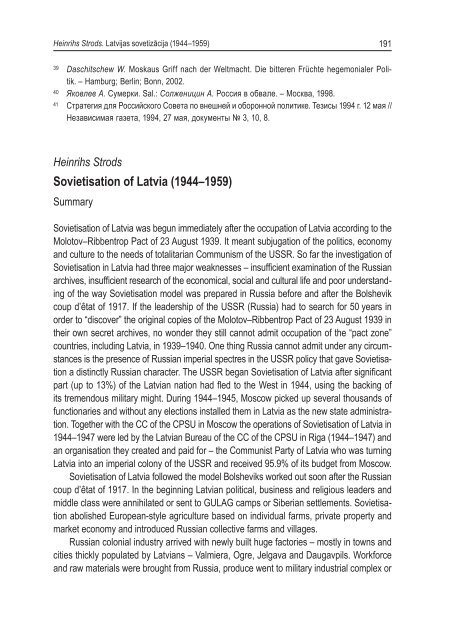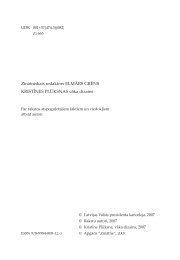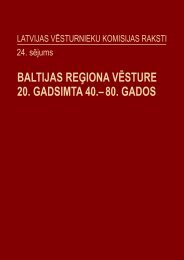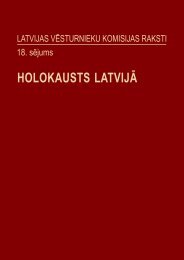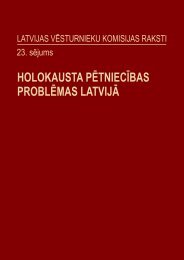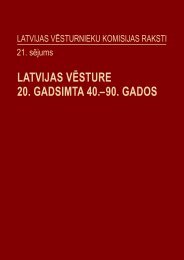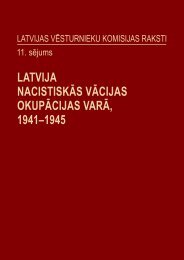15.sējums - Valsts prezidenta kanceleja
15.sējums - Valsts prezidenta kanceleja
15.sējums - Valsts prezidenta kanceleja
You also want an ePaper? Increase the reach of your titles
YUMPU automatically turns print PDFs into web optimized ePapers that Google loves.
Heinrihs Strods. Latvijas sovetizācija (1944–1959)<br />
39 Daschitschew W. Moskaus Griff nach der Weltmacht. Die bitteren Früchte hegemonialer Poli-<br />
tik. – Hamburg; Berlin; Bonn, 2002.<br />
40 Яковлев А. Сумерки. Sal.: Солженицин А. Россия в обвале. – Москва, 1998.<br />
41 Стратегия для Российcкого Совета по внешней и оборонной политике. Тезисы 1994 г. 12 мая //<br />
Независимая газета, 1994, 27 мая, документы No 3, 10, 8.<br />
Heinrihs Strods<br />
Sovietisation of Latvia (1944–1959)<br />
Summary<br />
Sovietisation of Latvia was begun immediately after the occupation of Latvia according to the<br />
Molotov–Ribbentrop Pact of 23 August 1939. It meant subjugation of the politics, economy<br />
and culture to the needs of totalitarian Communism of the USSR. So far the investigation of<br />
Sovietisation in Latvia had three major weaknesses – insufficient examination of the Russian<br />
archives, insufficient research of the economical, social and cultural life and poor understanding<br />
of the way Sovietisation model was prepared in Russia before and after the Bolshevik<br />
coup d’êtat of 1917. If the leadership of the USSR (Russia) had to search for 50 years in<br />
order to “discover” the original copies of the Molotov–Ribbentrop Pact of 23 August 1939 in<br />
their own secret archives, no wonder they still cannot admit occupation of the “pact zone”<br />
countries, including Latvia, in 1939–1940. One thing Russia cannot admit under any circumstances<br />
is the presence of Russian imperial spectres in the USSR policy that gave Sovietisation<br />
a distinctly Russian character. The USSR began Sovietisation of Latvia after significant<br />
part (up to 13%) of the Latvian nation had fled to the West in 1944, using the backing of<br />
its tremendous military might. During 1944–1945, Moscow picked up several thousands of<br />
functionaries and without any elections installed them in Latvia as the new state administration.<br />
Together with the CC of the CPSU in Moscow the operations of Sovietisation of Latvia in<br />
1944–1947 were led by the Latvian Bureau of the CC of the CPSU in Riga (1944–1947) and<br />
an organisation they created and paid for – the Communist Party of Latvia who was turning<br />
Latvia into an imperial colony of the USSR and received 95.9% of its budget from Moscow.<br />
Sovietisation of Latvia followed the model Bolsheviks worked out soon after the Russian<br />
coup d’êtat of 1917. In the beginning Latvian political, business and religious leaders and<br />
middle class were annihilated or sent to GULAG camps or Siberian settlements. Sovietisation<br />
abolished European-style agriculture based on individual farms, private property and<br />
market economy and introduced Russian collective farms and villages.<br />
Russian colonial industry arrived with newly built huge factories – mostly in towns and<br />
cities thickly populated by Latvians – Valmiera, Ogre, Jelgava and Daugavpils. Workforce<br />
and raw materials were brought from Russia, produce went to military industrial complex or<br />
191


